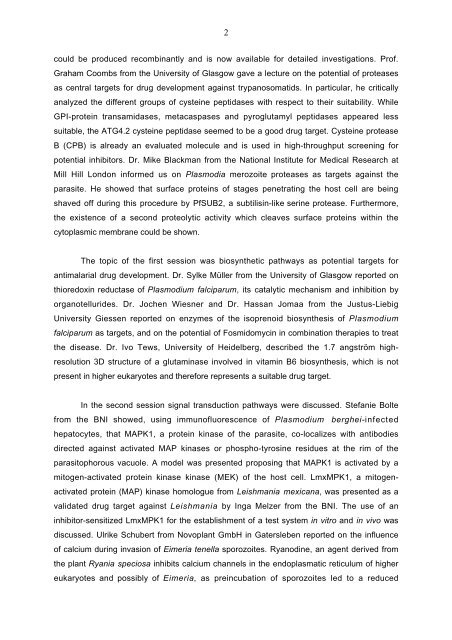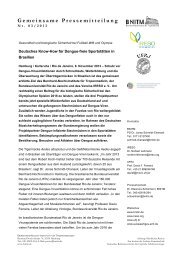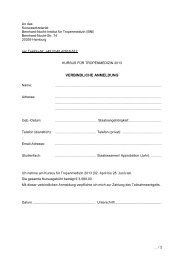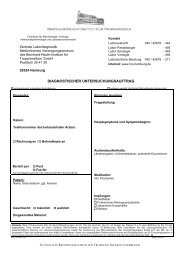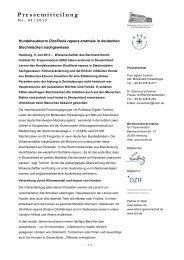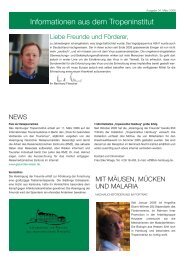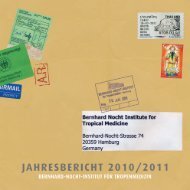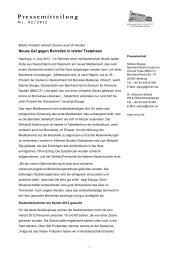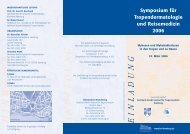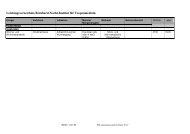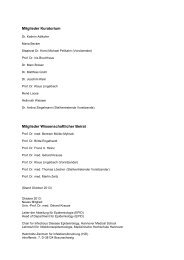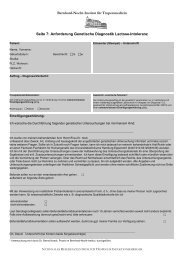Conference report (englisch/English) - Bernhard-Nocht-Institut für ...
Conference report (englisch/English) - Bernhard-Nocht-Institut für ...
Conference report (englisch/English) - Bernhard-Nocht-Institut für ...
Create successful ePaper yourself
Turn your PDF publications into a flip-book with our unique Google optimized e-Paper software.
2could be produced recombinantly and is now available for detailed investigations. Prof.Graham Coombs from the University of Glasgow gave a lecture on the potential of proteasesas central targets for drug development against trypanosomatids. In particular, he criticallyanalyzed the different groups of cysteine peptidases with respect to their suitability. WhileGPI-protein transamidases, metacaspases and pyroglutamyl peptidases appeared lesssuitable, the ATG4.2 cysteine peptidase seemed to be a good drug target. Cysteine proteaseB (CPB) is already an evaluated molecule and is used in high-throughput screening forpotential inhibitors. Dr. Mike Blackman from the National <strong>Institut</strong>e for Medical Research atMill Hill London informed us on Plasmodia merozoite proteases as targets against theparasite. He showed that surface proteins of stages penetrating the host cell are beingshaved off during this procedure by PfSUB2, a subtilisin-like serine protease. Furthermore,the existence of a second proteolytic activity which cleaves surface proteins within thecytoplasmic membrane could be shown.The topic of the first session was biosynthetic pathways as potential targets forantimalarial drug development. Dr. Sylke Müller from the University of Glasgow <strong>report</strong>ed onthioredoxin reductase of Plasmodium falciparum, its catalytic mechanism and inhibition byorganotellurides. Dr. Jochen Wiesner and Dr. Hassan Jomaa from the Justus-LiebigUniversity Giessen <strong>report</strong>ed on enzymes of the isoprenoid biosynthesis of Plasmodiumfalciparum as targets, and on the potential of Fosmidomycin in combination therapies to treatthe disease. Dr. Ivo Tews, University of Heidelberg, described the 1.7 angström highresolution3D structure of a glutaminase involved in vitamin B6 biosynthesis, which is notpresent in higher eukaryotes and therefore represents a suitable drug target.In the second session signal transduction pathways were discussed. Stefanie Boltefrom the BNI showed, using immunofluorescence of Plasmodium berghei-infectedhepatocytes, that MAPK1, a protein kinase of the parasite, co-localizes with antibodiesdirected against activated MAP kinases or phospho-tyrosine residues at the rim of theparasitophorous vacuole. A model was presented proposing that MAPK1 is activated by amitogen-activated protein kinase kinase (MEK) of the host cell. LmxMPK1, a mitogenactivatedprotein (MAP) kinase homologue from Leishmania mexicana, was presented as avalidated drug target against Leishmania by Inga Melzer from the BNI. The use of aninhibitor-sensitized LmxMPK1 for the establishment of a test system in vitro and in vivo wasdiscussed. Ulrike Schubert from Novoplant GmbH in Gatersleben <strong>report</strong>ed on the influenceof calcium during invasion of Eimeria tenella sporozoites. Ryanodine, an agent derived fromthe plant Ryania speciosa inhibits calcium channels in the endoplasmatic reticulum of highereukaryotes and possibly of Eimeria, as preincubation of sporozoites led to a reduced


